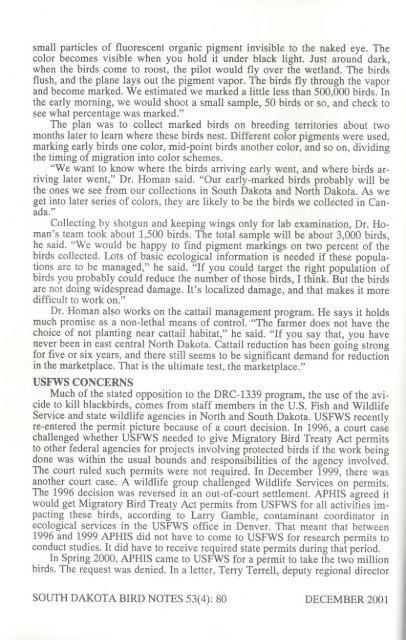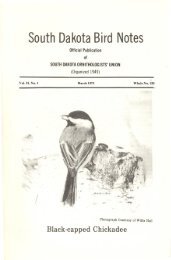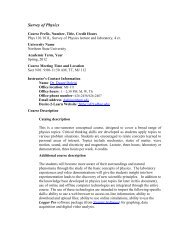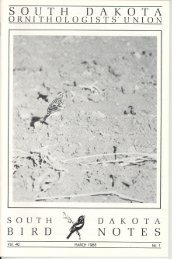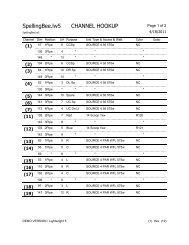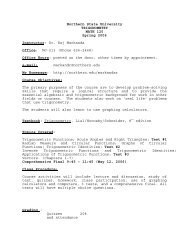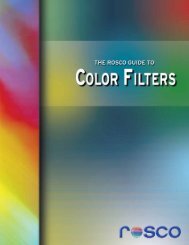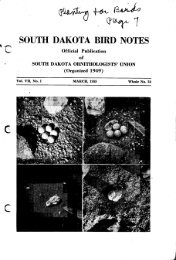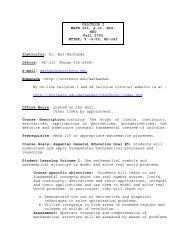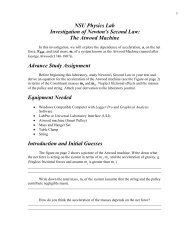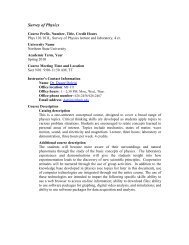Vol 53, 2001 - Northern State University
Vol 53, 2001 - Northern State University
Vol 53, 2001 - Northern State University
You also want an ePaper? Increase the reach of your titles
YUMPU automatically turns print PDFs into web optimized ePapers that Google loves.
small particles of fluorescent organic pigment invisible to the naked eye. Thecolor becomes visible when you hold it under black light. Just around dark,when the birds come to roost, the pilot would fly over the wetland. The birdsflush, and the plane lays out the pigment vapor. The birds fly through the vaporand become marked. We estimated we marked a little less than 500,000 birds. Inthe early morning, we would shoot a small sample, 50 birds or so, and check tosee what percentage was marked."The plan was to collect marked birds on breeding territories about twomonths later to learn where these birds nest. Different color pigments were used,marking early birds one color, mid-point birds another color, and so on, dividingthe timing of migration into color schemes."We want to know where the birds arriving early went, and where birds arrivinglater went," Dr. Homan said. "Our early-marked birds probably will bethe ones we see from our collections in South Dakota and North Dakota. As weget into later series of colors, they are likely to be the birds we collected in Canada."Collecting by shotgun and keeping wings only for lab examination, Dr. Homan'steam took about 1,500 birds. The total sample will be about 3,000 birds,he said. "We would be happy to find pigment markings on two percent of thebirds collected. Lots of basic ecological information is needed if these populationsare to be managed," he said. "If you could target the right population ofbirds you probably could reduce the number of those birds, I think. But the birdsare not doing widespread damage. It's localized damage, and that makes it moredifficult to work on."Dr. Homan also works on the cattail management program. He says it holdsmuch promise as a non-lethal means of control. "The farmer does not have thechoice of not planting near cattail habitat," he said. "If you say that, you havenever been in east central North Dakota. Cattail reduction has been going strongfor five or six years, and there still seems to be significant demand for reductionin the marketplace. That is the ultimate test, the marketplace."USFWS CONCERNSMuch of the stated opposition to the DRC-1339 program, the use of the avicideto kill blackbirds, comes from staff members in the U.S. Fish and WildlifeService and state wildlife agencies in North and South Dakota. USFWS recentlyre-entered the permit picture because of a court decision. In 1996, a court casechallenged whether USFWS needed to give Migratory Bird Treaty Act permitsto other federal agencies for projects involving protected birds if the work beingdone was within the usual bounds and responsibilities of the agency involved.The court ruled such permits were not required. In December 1999, there wasanother court case. A wildlife group challenged Wildlife Services on permits.The 1996 decision was reversed in an out-of-court settlement. APHIS agreed itwould get Migratory Bird Treaty Act permits from USFWS for all activities impactingthese birds, according to Larry Gamble, contaminant coordinator inecological services in the USFWS office in Denver. That meant that between1996 and 1999 APHIS did not have to come to USFWS for research permits toconduct studies. It did have to receive required state permits during that period.In Spring 2000, APHIS came to USFWS for a permit to take the two millionbirds. The request was denied. In a letter, Terry Terrell, deputy regional directorSOUTH DAKOTA BIRD NOTES <strong>53</strong>(4): 80 DECEMBER <strong>2001</strong>


